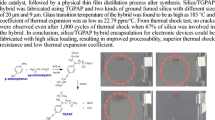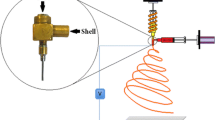Abstract
In this study, a low-temperature post processing of silica gel for high-temperature stable LED encapsulant was developed. The results indicated that the silica gels prepared by 1st post heat treatment at 300 °C for 5 h and then 2nd post processing at 80 °C for 50 h can have similar low weight loss and high transmittance as the silica gels were processed at 800 °C for 5 h. The result of such low processing temperature implies it may be possible to encapsulate inorganic gel on LED as the convenient potting method is being used in silicone encapsulation technology. However, the processing time can be greatly reduced if vacuum oven is used. Further surface impermeability improvement is also possible by additional local surface heat treatment. The advantages of adopting silica encapsulant in LED modules include higher thermal stability and better optical performance consistency in lumen, color temperature, etc. in new applications.








Similar content being viewed by others

References
Lin YH, You JP, Lin YC, Tran NT, Shi FG (2010) Development of high-performance optical silicone for the packaging of high-power LEDs. Compon Packag Technol 33(4):761–766. doi:10.1109/TCAPT.2010.2046488
Narendran N, Gu Y, Freyssinier JP, Yu H, Deng L (2004) Solid-state lighting: failure analysis of white LEDs. J Cryst Growth 268(3–4):449–456. doi:10.1016/j.jcrysgro.2004.04.071
Yanagisawa T, Kojima T (2005) Long-term accelerated current operation of white light-emitting diodes. Luminescence 114(1):39–42. doi:10.1016/j.jlumin.2004.11.010
Wang J, Tsai CC, Cheng WC, Chen MH, Chung CH, Cheng WH (2011) High thermal stability of phosphor-converted white light-emitting diodes employing Ce: YAG-doped glass. Sel Top Quantum Electron 17(3):741–746. doi:10.1109/JSTQE.2010.2096459
Elger G, Hutter M, Oppermann H, Aschenbrenner R, Reichl H, Jäger E (2002) Development of an assembly process and reliability investigations for flip-chip LEDs using the AuSn soldering. Microsys. Technol 7(5–6):239–243. doi:10.1007/s005420100103
Nishiura S, Tanabe S, Fujioka K, Fujimoto Y (2011) Properties of transparent Ce:YAG ceramic phosphors for white LED. Opt Mater 33(5):688–691. doi:10.1016/j.optmat.2010.06.005
Nogami M, Abe Y (1994) Sol–gel method for synthesizing visible photoluminescent nanosized Ge-crystal-doped silica glasses. Appl Phys 65(20):2545–2547. doi:10.1063/1.112630
Duran A, Serna C, Fornes V, Fernandez Navarro JM (1986) Structural considerations about SiO2 glasses prepared by SOL–GEL. Spain J Non –Cryst Solids 82(1–3):69–77. doi:10.1016/0022-3093(86)90112-2
Shin SR, Lee ZH, Cho GS, Lee KW (2004) Hydrogen gas pick-up mechanism of Al-alloy melt during lost foam casting. J Mater Sci 39(5):1563–1569. doi:10.1023/B:JMSC.0000016152.96919.6c
Khalil KMS, Makhlouf SA (2008) High surface area thermally stabilized porous iron oxide/silica nanocomposites via a formamide modified sol–gel process. Appl Surf Sci 254(13):3767–3773. doi:10.1016/j.apsusc.2007.11.066
Matijasevic GS, Lee CC, Wang CY (1993) Au/Sn alloy phase diagram and properties related to its use as a bonding medium. Thin Solid Films 223(2):276–287. doi:10.1016/0040-6090(93)90533-U
Nogami M, Moriya Y (1980) Glass formation through hydrolysis of Si(OC2H5)4 with NH4OH and HCl solution. J Non Cryst Solids 37(2):191–201. doi:10.1016/0022-3093(80)90150-7
Sakka S, Kamiya K (1980) Glasses from metal alcoholates. J Non Cryst Solids 42(1–3):403–421. doi:10.1016/0022-3093(80)90040-X
Agarwal A, Davis KM, Tomozawa M (1995) A simple IR spectroscopic method for determining fictive temperature of silica glasses. Non Cryst Solids 185(1–2):191–198. doi:10.1016/0022-3093(94)00676-8
Lowry RK (1999) Sources and control of volatile gases hazardous to hermetic electronic enclosures. In:International symposium on advanced packaging materials: processes, properties and interfaces, 94–99
Tennent NH (1979) Clear and pigmented epoxy resins for stained glass conservation: light ageing studies. Stud Conserv 24(4):153–164. doi:10.2307/1505777
Acknowledgments
This work was partially supported by National Science Council of Republic of China, Taiwan, R.O.C under Contract NSC101-3113-E-110-002-CC2.
Author information
Authors and Affiliations
Corresponding author
Rights and permissions
About this article
Cite this article
Wang, JS., Huang, SY. Potential of low-temperature post processing of silica gel for high-temperature stable LED encapsulant. J Sol-Gel Sci Technol 64, 557–563 (2012). https://doi.org/10.1007/s10971-012-2889-1
Received:
Accepted:
Published:
Issue Date:
DOI: https://doi.org/10.1007/s10971-012-2889-1



